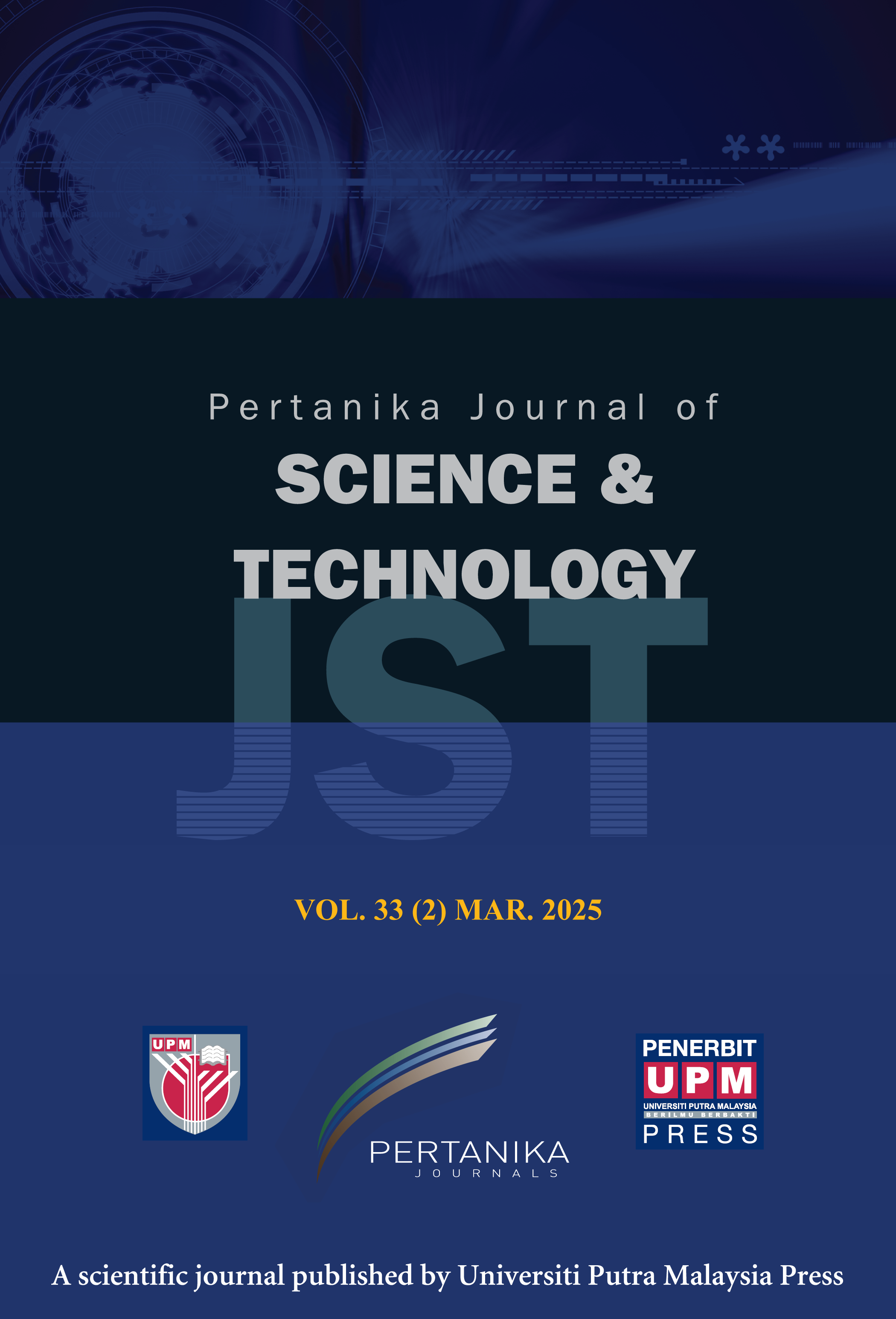PERTANIKA JOURNAL OF SCIENCE AND TECHNOLOGY
e-ISSN 2231-8526
ISSN 0128-7680
J
J
Pertanika Journal of Science & Technology, Volume J, Issue J, January J
Keywords: J
Published on: J
J
-
Adams, R. J. (2005). Reliability as a measurement design effect. Studies in Educational Evaluation, 31(2-3), 162-172. https://doi.org/10.1016/j.stueduc.2005.05.008
-
Adams, R. J., Wu, M. L., Cloney, D., Berezner, A., & Wilson, M. (2020). ACER ConQuest: Generalised Item Response Modelling Software (Version 5.29) [Computer software]. Australian Council for Educational Research. https://www.acer.org/au/conquest
-
Adams, R., & Khoo, S. (1996). Quest: Interactive test analysis system version 2.1. The Australian council for educational research. https://eric.ed.gov/?d=ED362553
-
Al-Alawneh, M. K., Hawamleh, M. S., Al-Jamal, D. A., & Sasa, G. S. (2019). Communication skills in practice. International Journal of Learning, Teaching and Educational Research, 18(6), 1-19. https://doi.org/10.26803/ijlter.18.6.1
-
American Educational Research Association. (2014). Standards for educational and psychological testing (6th ed). https://www.testingstandards.net/uploads/7/6/6/4/76643089/9780935302356.pdf
-
Anakttototy, K., Sekawael, M., Latief, M. R. A., & Bin-Hady, W. R. A. (2023). Beyond linguistics: Exploring the cognitive and motivational barriers to essay writing for tertiary students. International Journal of Language Education, 7(3), 447-468. https://doi.org/10.26858/ijole.v7i3.37070
-
Baker, F. B., & Kim, S. (2017). The basics of item response theory using R. Springer. https://link.springer.com/book/10.1007/978-3-319-54205-8
-
Canto-Sperber, M., & Depuy, J. P. (2001). Competencies for good life and good society. In D. Rychen & L. Salganik (Eds.), Defining and selecting competencies (pp. 67-92). Hogrefe Publishing.
-
DeMars, C. (2010). Item response theory: Understanding statistics measurement. Oxford University Press. https://doi.org/10.1093/acprof:oso/9780195377033.001.0001
-
Flanagan, J. C. (1954). The critical incident technique. Psychological Bulletin, 51(4), 327-357. https://doi.org/10.1037/h0061470
-
Grayling, A. (2017). Future education and skills: Education 2030: Reflections on transformative competencies 2030. Organization for Economic Co-operation and Development. https://www.oecd.org/education/2030-project/contact/EDU-EDPC(2017)16-ANN5.pdf
-
Halpern, D. F., & Dunn, D. S. (2021). Critical thinking: A model of intelligence for solving real-world problems. The Journal of Intelligence, 9(2), Article 22. https://doi.org/10.3390/jintelligence9020022
-
Haste, H. (2001). Ambiguity, autonomy, and agency: Psychological challenges to new competence. In D. Rychen & L. Salganik (Eds.), Defining and selecting competencies (pp. 93-120). Hogrefe Publishing. https://api.semanticscholar.org/CorpusID:142385997
-
Hipkins, R. (2012). The engaging nature of teaching for competency development. In S. L. Christenson, A. L. Reschly & C. Wylie (Eds.), Handbook of research on student engagement (pp. 441-456). Springer. https://doi.org/10.1007/978-1-4614-2018-7_21
-
Junpeng, P., Marwiang, M., Chiajunthuk, S., Suwannatrai, P., Chanayota, K., Pongboriboon, K., Tang, K. N., & Wilson, M. (2020). Validation of a digital tool for diagnosing mathematical proficiency. International Journal of Evaluation and Research in Education, 9(3), 665-674. https://doi.org/10.11591/ijere.v9i3.20503
-
Kesorn, N., Junpeng, P., Marwiang, M., Pongboriboon, K., Tang, K. N., Bathia, S., & Wilson, M. (2020). Development of an assessment tool for mathematical reading, analytical thinking and mathematical writing. International Journal of Evaluation and Research in Education, 9(4), 955-962. https://doi.org/10.11591/ijere.v9i4.20505
-
Krathwohl, D. R., Bloom, B. S., & Masia, B. B. (1964). Taxonomy of educational objectives: Handbook II: The affective domain. David McKay Publications https://scholar.google.com/scholar_lookup?title=Taxonomy+of+educational+objectives%3A+The+classification+of+educational+goals.+Handbook+II%3A+Affective+domain&author=DR+Krathwohl&author=BS+Bloom&author=BB+Masia&publication_year=1964
-
Laukonnen, R., Biddel, H., & Gallagher, R. (2018). Preparing humanity for change and artificial intelligence: Learning to learn as a safeguard against volatility, uncertainty, complexity and ambiguity. Organization for Economic Co-operation and Development. https://doi.org/10.31234/osf.io/g5qwc
-
Lohse-Bossenz, H., Kunina-Habenicht, O., & Kunter, M. (2013). The role of educational psychology in teacher education: Expert opinions on what teachers should know about learning, development, and assessment. European Journal of Psychology of Education, 28(4), 1543-1565. https://doi.org/10.1007/s10212-013-0181-6
-
Masters, G. N., & Wright, B. D. (1997). The partial credit model. In W. J. van der Linden & R. K. Hambleton (Eds.). Handbook of modern item response theory. Springer. https://doi.org/10.1007/978-1-4757-2691-6_6
-
Mezirow, J. (2003). Transformative learning as discourse. Journal of Transformative Education, 1(1), 58-63. https://doi.org/10.1177/1541344603252172
-
Nägele, C., & Stalder, B. E. (2017). Competence and the need for transferable skills. In M. Mulde (Ed.), Competence-based vocational and professional education: Bridging the worlds of work and education (pp.739-753). Springer. https://doi.org/10.1007/978-3-319-41713-4
-
Nussbaum, M. (1997). Cultivating humanity: A classical defense of reform in liberal education. Harvard University Press. https://doi.org/10.2307/j.ctvjghth8
-
Organization for Economic Cooperation and Development (OECD). (2017). Education 2030 - Conceptual learning framework: Background papers. The future of education and skills: Education 2030. https://one.oecd.org/document/EDU/EDPC(2017)25/ANN3/en/pdf
-
Organization for Economic Cooperation and Development. (2018). OECD future of education and skills 2030 https://www.oecd.org/education/2030?E2030%20Position%20Paper%(05.04.2018).pdf.
-
Padilla, J. L., & Leighton, J. P. (2017). Cognitive interviewing and think aloud methods. In B. Zumbo & A. Hubley (Eds.), Understanding and investigating response processes in validation research (pp 11-228). Springer. https://doi.org/10.1007/978-3-319-56129-5_12
-
Rasch, G. (1960). Probabilistic models for some intelligence and attainment tests. Danmarks Paedagogiske Institut. https://books.google.co.th/books?id=aB9qLgEACAAJ
-
Reeves, T. C. (2006). Design research from a technology perspective. In J. V. D. Akker, K. Gravemeijer, S. McKenney & N. Nieveen (Eds.), Educational design research (pp. 52-66). Routledge. https://www.taylorfrancis.com/chapters/edit/10.4324/9780203088364-13/design-research-technology-perspective-thomas-reeves
-
Stodden, D. F., Pesce, C., Zarrett, N., Tomporowski, P., Ben-Soussan, T. D., Brian, A., Abrams, T. C., & Weist, M. D. (2023). Holistic functioning from a developmental perspective: A new synthesis with a focus on a multi-tiered system support structure. Clinical Child and Family Psychology Review, 26(2), 343-361. https://doi.org/10.1007/s10567-023-00428-5
-
Vongvanich, S. (2020). Design research in education. Chulalongkorn University Printing House. https://www.chulabook.com/education/102930
-
Webb, N. L. (1997). Criteria for alignment of expectations and assessments in mathematics and science education. National Institute for Science Education. https://eric.ed.gov/?id=ED414305
-
Wilson, M. R. (2005). Constructing measures: An item response modeling approach. Routledge. https://doi.org/10.4324/9781410611697
-
Wilson, M., Allen, D. D., & Li, J. C. (2006). Improving measurement in health education and health behavior research using item response modelling: Comparison with the classical test theory approach. Health Education Research, 2(1), i19-i32. https://doi.org/10.1093/her/cyl053
-
Wolff, J. (2015). Political philosophy and the real world of the welfare state. Journal of Applied Philosophy, 32(4), 360-372.
-
Yazon, A. D., Ang-Manaig, K., Buama, C. A. C., & Tesoro, J. F. B. (2019). Digital literacy, digital competence and research productivity of educators. Universal Journal of Educational Research, 7(8), 1734-1743. https://doi.org/10.13189/ujer.2019.070812
-
Zajda, J. (2021). Constructivist learning theory and creating effective learning environments. In J. Zajda (Ed.), Globalisation and education reforms: Creating effective learning environments (pp. 35-50). Springer. https://doi.org/10.1007/978-3-030-71575-5_3
ISSN 0128-7680
e-ISSN 2231-8526




